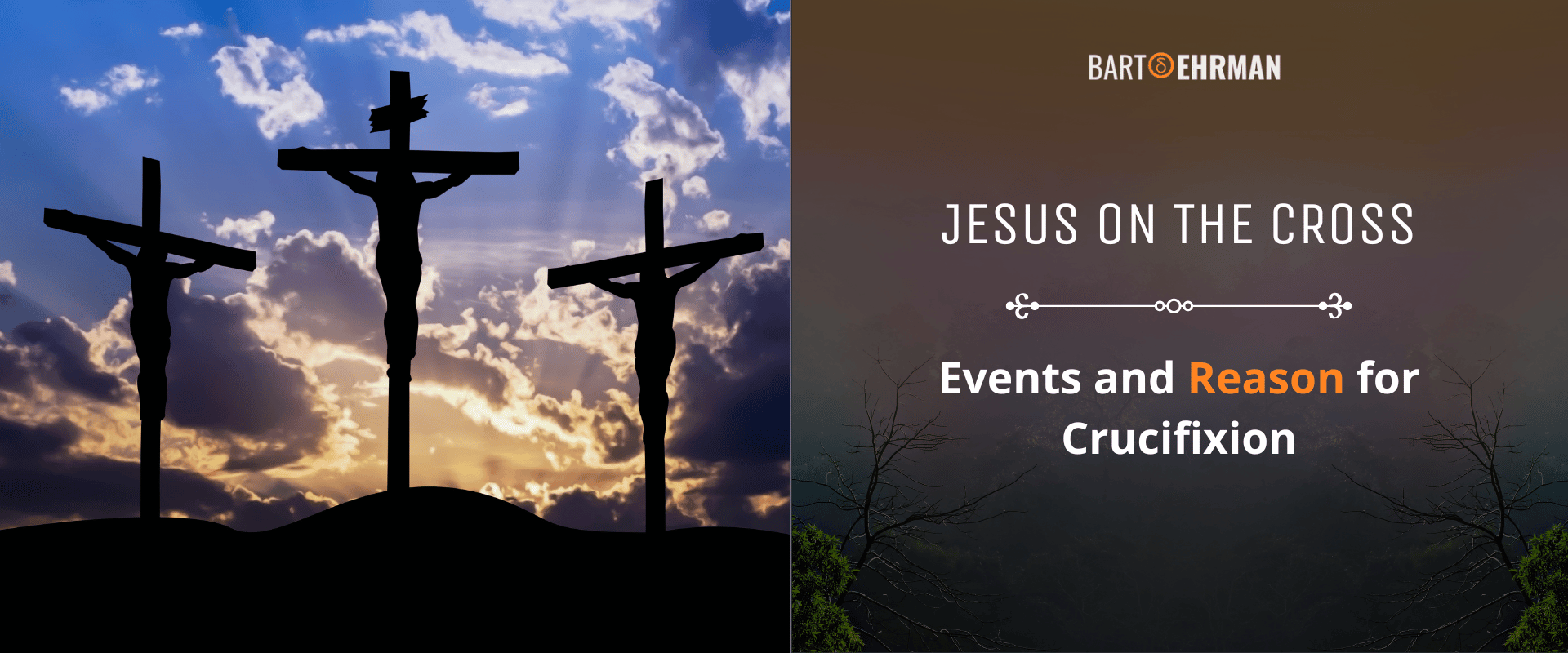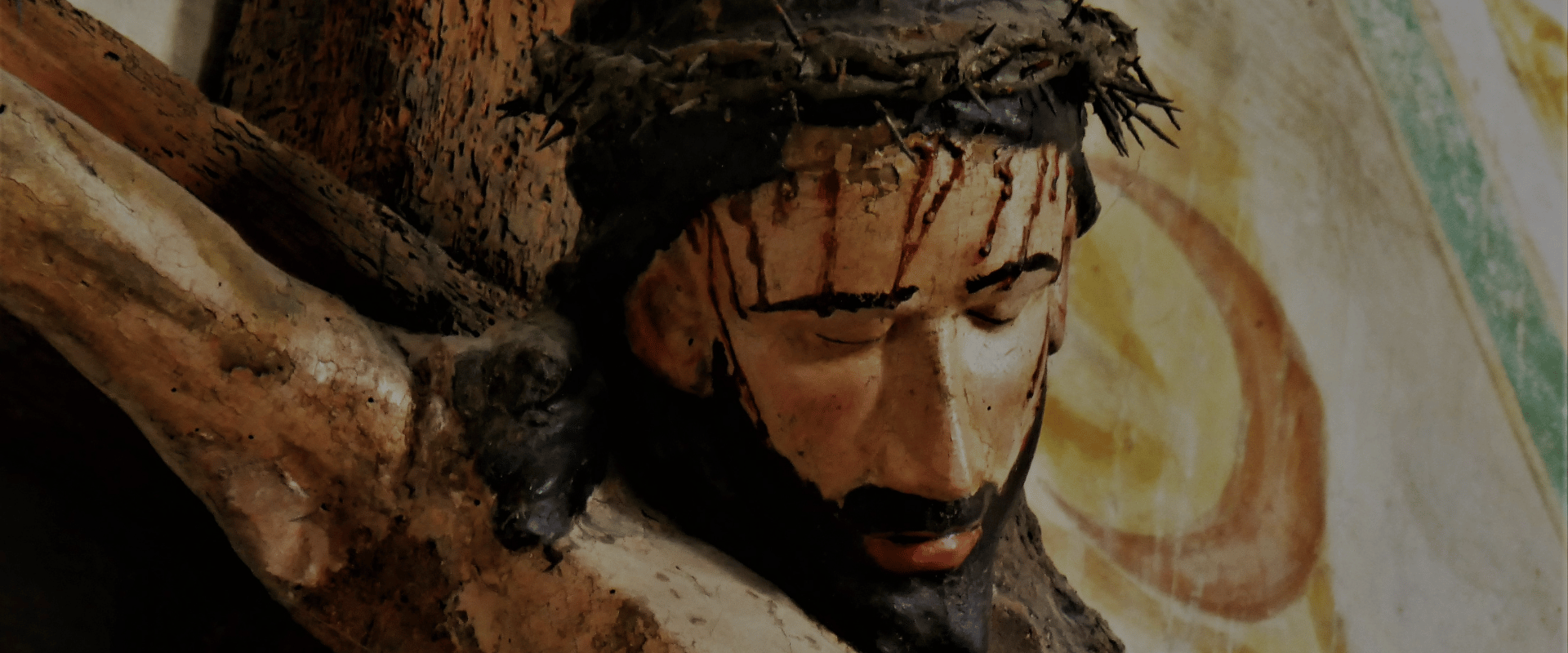Jesus on the Cross: Events and Reason for Crucifixion

Written by Joshua Schachterle, Ph.D
Author | Professor | Scholar
Author | Professor | BE Contributor
Verified! See our editorial guidelines
Verified! See our guidelines
Date written: July 27th, 2024
Disclaimer: The views and opinions expressed in this article belong to the author and do not necessarily match my own. - Dr. Bart D. Ehrman
The crucifixion of Jesus is among the most significant events in Christian history, symbolizing sacrifice, redemption, and the foundation of faith for many. In this article I’ll examine the events leading to Jesus on the cross as told in the New Testament, as well as the cultural, religious, and political factors that converged to bring it about.
Starting with an examination of when Jesus was executed and by whom, I’ll next detail the events included in the Gospels’ crucifixion narratives. Finally, I’ll address why Jesus was executed, including the opinions of several scholars on the matter.

When Did the Crucifixion of Jesus Happen?
According to Mark, Jesus ate his Last Supper as a Passover meal on a Thursday night. In fact, if we assume, as most scholars do, that Jesus was then killed during the week of Passover, it’s logical to assume he died during the month of Nisan. In Jesus' time, that would likely have put his death in our month of April.
In their article “Dating the Crucifixion,” physicists Colin Humphreys and W.G. Waddington say that by making astronomical calculations to reconstruct the Jewish calendar in the 1st century CE, they can prove the crucifixion happened on April 3. This depends, of course, on information from the Gospels which may or may not be historically accurate, so take the date with a grain of salt.
Specifically, Mark 25 says Jesus was crucified “at the third hour” which was 9:00 AM in the time-keeping system used then. John 19, on the other hand, says it happened at noon.
What year did the crucifixion of Jesus happen? Scholars say there are two possibilities: 30 CE or 33 CE. While either of these years is certainly plausible, most scholars think 30 CE is a more likely year since, according to Bart Ehrman, Paul’s conversion occurred around 32-33 CE.
If this is accurate, and if we believe Paul’s claim that he had been persecuting Christians for a while before converting, we can work backwards to an approximate year of 30 CE for Jesus’ crucifixion. I should point out, though, that this is highly speculative.
The scholarly consensus says Jesus was born around 4 BCE. If he was crucified in 30, that would make him 34 at his crucifixion.
Who Crucified Jesus?
For centuries, people used the belief that Jesus was killed by Jews to justify antisemitism. Ironically, this assumption is based on a complete misunderstanding of our evidence.
First, Jews did not and could not use crucifixion as a means of execution. The Jewish council, for example, accuses Jesus in the New Testament of blasphemy. If that were Jesus’ only crime, Jewish writings like the Mishnah, a massive, written collection of Jewish oral traditions, say that Jesus should have been stoned to death. Only the Romans used crucifixion.
As Kaufman Kohler and Emil Hirsch write, “The mode and manner of Jesus' death undoubtedly point to Roman customs and laws as the directive power.” Later on, I’ll talk about why the Romans executed Jesus.
FREE COURSE!
WHY I AM NOT A CHRISTIAN
Raw, honest, and enlightening. Bart's story of why he deconverted from the Christian faith.
Over 6,000 enrolled!
What Happened at Jesus’ Crucifixion?
In the Gospels, a series of events lead up to the stories of Jesus on the cross. Here I’ll examine the most significant ones.
Mocking and Beatings
All four Gospels say the Roman guards who took Jesus away to be crucified first mocked him. Mark 15:17-19 describes it like this:
And they clothed him in a purple cloak, and after twisting some thorns into a crown they put it on him. And they began saluting him, “Hail, King of the Jews!” They struck his head with a reed, spat upon him, and knelt down in homage to him.
Luke 22:63-65 adds a detail to this depiction. In Luke, the guards blindfold Jesus, strike him, and then say “Prophesy! Who is it who struck you?” In other words, they mock both the royal role ascribed to Jesus and the prophetic one, tearing down his identity as both a political and religious leader.
In addition to this indignity, Jesus is flogged before being crucified. Flogging or scourging was a process wherein condemned criminals had their backs whipped by a “flagellum,” a short whip made of three or more leather straps connected by a handle. The leather straps were tied with weights at the end which were implanted with bits of metal, nails, or bone shards. These would pull out the victim’s flesh.
Carrying the Cross
Kohler and Hirsch note that people condemned to be crucified were normally forced to carry not the entire cross to the place of execution, but only the horizontal cross-beam. However, the Synoptic Gospels, Matthew, Mark, and Luke, all say another person was compelled to carry Jesus’ cross. Mark 15:21 says the guards “compelled a passer-by, who was coming in from the country, to carry his cross; it was Simon of Cyrene, the father of Alexander and Rufus.”
Only in the Gospel of John is Jesus forced to carry his own cross. As John 19:16-17 puts it, “So they took Jesus, and carrying the cross by himself he went out to what is called the Place of the Skull, which in Hebrew is called Golgotha.”
The Crucifixion, Witnesses, and the Sign Over the Cross
Who was present at Jesus’ crucifixion? Certainly the Roman soldiers who administered the punishment were. Additionally, the Gospels all agree there were some random passersby who came to see the crucifixion. Finally, the Synoptics all say the Jewish religious authorities were there. Mark 15:31-32, for instance, says:
In the same way the chief priests, along with the scribes, were also mocking him among themselves and saying, “He saved others; he cannot save himself. Let the Messiah, the King of Israel, come down from the cross now, so that we may see and believe.”
Only in John, however, are friends and family present with Jesus on the cross. Specifically, John 19:25-27 says that Jesus’ mother and one of his aunts are there, along with a woman named Mary the wife of Clopas, Mary Magdalene, and the disciple whom Jesus loved.
Kohler and Hirsch note that it was common to have the charge against the criminal — called a titulus in Latin — written and fixed to the cross, presumably to clarify to others that if they committed the same crime, they would receive the same punishment. All four Gospels, while they differ slightly, agree that the sign above Jesus’ head said “King of the Jews.” This will give us a clue to why Jesus was crucified, as I’ll discuss later.
Jesus’ Last Words
The Gospels also differ about the last words of Jesus on the cross before he passed away. Mark 15:34 says that Jesus cried out “Eloi, Eloi, lema sabachthani?” which means, “My God, my God, why have you forsaken me?” Matthew 27:46 says the same but has a slightly different spelling of the Aramaic phrase: “Eli, Eli, lema sabachthani?”
It’s important to note, by the way, that this phrase comes from Psalm 22:1 and, therefore, ties Jesus not only to God but to David who was believed to have written the Psalms.
Luke 23:46 omits the above phrase, instead saying that Jesus’ last words were “Father, into your hands I commend my spirit.” Unlike Mark and Matthew’s versions, Luke’s Jesus doesn’t feel abandoned by God, still calling him Father and apparently seeing his death as a homecoming. John 19:30 ends Jesus’ life with the most succinct phrase, “It is finished.”

Why Did the Romans Put Jesus on the Cross?
The reason the Romans crucified Jesus has long been a matter of debate among scholars. As I mentioned earlier, if Jesus’ principal crime had been blasphemy against the Jewish God, the Jews themselves would likely have stoned him to death. Instead, the Romans took charge. Let’s look briefly at some scholarly opinions on why Jesus was killed.
In The Religion of Jesus the Jew, Geza Vermes writes that Jesus’ cleansing of the Temple, the scene portrayed in Mark 11:15-19, and others in which he drives the money changers out, sealed Jesus’ fate. (Affiliate Disclaimer: We may earn commissions on products you purchase through this page at no additional cost to you. Thank you for supporting our site!) He writes that “nervous authorities in charge of law and order” were frightened by Jesus’ violent outburst, especially during the time of Passover, when Jews celebrated liberation from an oppressor. By this reasoning, the Jews brought Jesus to the attention of Roman authorities to prevent the Romans from punishing the entire Jewish population of Jerusalem because of Jesus’ troublesome actions.
In his book The Historical Jesus: The Life of a Mediterranean Jewish Peasant, John Dominic Crossan agrees that the cleansing of the Temple was the impetus for Jesus’ arrest given “the confined and tinder-box atmosphere of the temple at Passover,” suggesting that this “could easily have led to arrest and execution.”
However, in a blog post, Larry Hurtado notes the following:
Jesus didn’t simply die, he was killed, and not simply killed but executed, and not simply executed, he was crucified. We know from other incidents (as, e.g., reported by Josephus) how the Temple authorities and Roman administration treated people who simply caused a disturbance in the Temple, and it wasn’t crucifixion. Flogging, maybe but not crucifixion. The point of crucifixion wasn’t simply to end a person’s life but, much more, to humiliate and degrade to the extreme, to say “See what this guy got? This is what anyone gets who raises his hand against Rome!”
Hurtado’s point is well taken. For Rome to get involved, there had to be a perceived political threat from Jesus, which leads me to Bart Ehrman’s opinion.
Ehrman notes, first of all, that there is no evidence the Romans would have cared at all about Jesus committing blasphemy or any other internal Jewish disputes. Given that, Jesus must have been executed on political charges, made clear on the titulus hanging on his cross: he called himself King of the Jews.
Even if Jesus hadn’t explicitly called himself King of the Jews, scholars know much of the content of Jesus’ teachings centered on the Kingdom of God. Anyone publicly espousing a coming Kingdom while his own land was occupied by Rome could have been planning a coup, something Rome would never stand for.
Zohler and Hirsch note that crucifixion was primarily a political punishment for sedition against the empire. Jesus’ rhetoric about the Kingdom of God must have reached the ears of Rome, and Rome had a standard punishment for political insurgents (or even potential ones) . Remember, for example, that there were two others crucified with Jesus. The Greek word used to designate those other two is “lestas,” a word which can mean “bandit” but was more often used to mean one who had rebelled against Rome. Jesus was put in that same category and thus received the same punishment.
Conclusion
The details of the story of Jesus’ crucifixion are horrible in their brutality. However, according to ancient Roman sources, most of them fit with what scholars know of the crucifixion process in Jesus’ time.
Convicted political prisoners were first beaten, then forced to carry the cross-beam of their own instrument of death to a place of execution, usually high on a hill for greater visibility and deterrence. They were then nailed to the cross and hung there, anywhere from twelve hours to three days, until they finally died.
The fact that Jesus was crucified and not stoned to death makes it abundantly clear that it was Romans, not the Jews, who executed him. Furthermore, Rome generally only meted out such punishments to those perceived as potential or real threats to the empire. Whether true or not, Jesus was seen as a potential political threat which Rome had to crush.
FREE COURSE!
WHY I AM NOT A CHRISTIAN
Raw, honest, and enlightening. Bart's story of why he deconverted from the Christian faith.
Over 6,000 enrolled!
